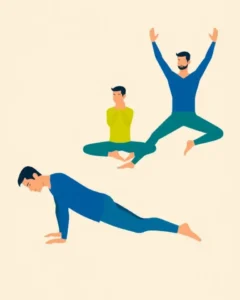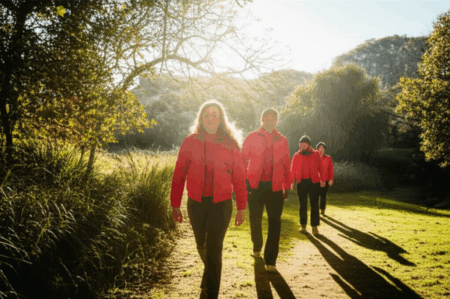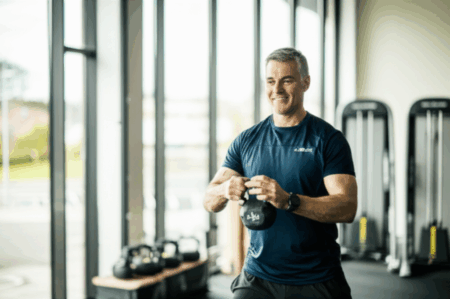Turning 40 is a milestone, but it doesn’t mean the end of feeling strong and energetic. For women, this decade often brings new physical and hormonal changes that can impact fitness. Building a sustainable exercise routine is key to navigating these changes, maintaining health, and feeling your best. It’s about finding a balance that works for your lifestyle and addresses your specific needs.
Understanding the Changes After 40
As women enter their 40s, several physiological shifts can influence their fitness journey.
- Hormonal shifts: Perimenopause, the transition to menopause, typically begins in a woman’s 40s. This phase is characterized by fluctuating estrogen levels, which can lead to symptoms like hot flashes, sleep disturbances, and mood swings. These hormonal changes can also affect muscle mass and bone density.
- Decreased muscle mass: After 40, women naturally begin to lose muscle mass, a process called sarcopenia. Muscle burns more calories than fat, so this loss can slow down metabolism and make it harder to manage weight.
- Reduced bone density: Hormonal changes, particularly the decline in estrogen, can accelerate bone loss, increasing the risk of osteopenia and osteoporosis.
- Metabolism slowdown: Metabolism tends to slow down with age, making it easier to gain weight.
- Increased risk of chronic diseases: The risk of developing conditions like heart disease, type 2 diabetes, and certain cancers increases with age.
- Longer recovery time: As we age, our bodies may require more time to recover from workouts. Connective tissues, especially in tendons, become more susceptible to injury and can take longer to heal.
Benefits of Exercise for Women Over 40
Despite these challenges, regular exercise offers a wealth of benefits for women over 40.
- Maintaining muscle mass: Strength training helps counter the effects of aging, allowing women to build and maintain muscle mass and strength.
- Strengthening bones: Weight-bearing exercises, like walking and strength training, can help maintain and even improve bone density, reducing the risk of osteoporosis.
- Boosting metabolism: Regular physical activity, including both cardio and strength training, can help boost metabolism and manage weight.
- Improving hormonal balance: Exercise can help regulate estrogen levels, improve insulin sensitivity, and boost the production of mood-enhancing hormones like serotonin and dopamine.
- Reducing the risk of chronic diseases: Physical activity can reduce the risk of heart disease, stroke, type 2 diabetes, and certain cancers.
- Enhancing mental health: Exercise is a natural mood booster, releasing endorphins that reduce stress, anxiety, and depression. It also promotes better sleep and mental clarity.
- Improving cognitive function: Studies have shown that physical activity can improve brain health and lower the risk of cognitive impairment.
- Increasing energy levels: Exercise can combat fatigue and increase overall energy levels.
- Improving sleep: Regular physical activity can improve sleep quality.
Building a Sustainable Exercise Routine
Creating a sustainable exercise routine involves finding activities you enjoy, setting realistic goals, and listening to your body.
1. Consult with your doctor
Before starting any new exercise program, especially if you have underlying health conditions, it’s essential to consult with your doctor. They can help you identify any potential risks and recommend appropriate exercises.
2. Set realistic goals
Start with small, achievable goals and gradually increase the intensity and duration of your workouts. Trying to do too much too soon can lead to burnout or injury.
3. Find activities you enjoy
The key to sticking with an exercise routine is to find activities you genuinely enjoy. This could include:
- Walking: A simple and accessible exercise that can be done anywhere, anytime. Brisk walking can improve cardiovascular health, strengthen bones, and boost mood.
- Running/Jogging: Excellent for cardiovascular fitness and burning calories. Start with short intervals and gradually increase the distance and intensity.
- Swimming: A low-impact exercise that’s easy on the joints. It’s a great way to improve cardiovascular fitness, strength, and flexibility.
- Cycling: Another low-impact option that’s good for cardiovascular health and leg strength.
- Dancing: A fun and engaging way to get your heart rate up and improve coordination.
- Group fitness classes: Classes like Zumba, aerobics, or Pilates can provide motivation and social support.
- Yoga: Improves flexibility, strength, balance, and relaxation.
- Pilates: Focuses on core strength, flexibility, and posture.
- Kickboxing: An excellent fat-burning exercise that tones the legs, butt, arms, and abs.
4. Incorporate strength training
Strength training is crucial for maintaining muscle mass and bone density. Aim for at least two strength training sessions per week, focusing on all major muscle groups. Examples include:
- Bodyweight exercises: Squats, lunges, push-ups, and planks can be done at home without any equipment.
- Weight lifting: Using dumbbells, barbells, or weight machines to build strength.
- Resistance bands: A versatile and portable option for strength training.
5. Prioritize Cardio
Cardiovascular exercise is incredibly critical for women over 40. Aim to do cardio work at least three times a week to improve your muscle tone and bone density and maintain overall good health. This cardiovascular exercise could be in the form of short bursts of intense activity (like sprinting) or long, low-impact exercises like brisk walking or jogging.
6. Don’t neglect flexibility and balance
Flexibility exercises, like stretching and yoga, can improve range of motion and reduce the risk of injury. Balance exercises, like tai chi, can help prevent falls, especially important as we age.
7. Listen to your body
Pay attention to your body’s signals and rest when you need to. Don’t push yourself too hard, especially when starting a new exercise routine.
8. Stay consistent
Consistency is key to seeing results. Aim to exercise most days of the week, even if it’s just for a short period of time.
9. Make it a habit
Incorporate exercise into your daily routine by scheduling it like any other important appointment.
10. Find a workout buddy
Exercising with a friend can provide motivation and accountability.
11. Vary your routine
Avoid doing the same workout day after day to prevent boredom and plateaus. Mix things up by trying new activities or changing the intensity and duration of your workouts.
12. Stay hydrated
Drink plenty of water before, during, and after exercise.
13. Fuel your body
Eat a balanced diet that supports your activity level.
14. Be patient
It takes time to see results. Don’t get discouraged if you don’t see changes overnight. Stick with your routine and celebrate your progress along the way.
Sample Workout Routine
Here’s a sample workout routine for women over 40, which can be adjusted based on individual fitness levels and preferences:
- Monday: Strength training (upper body)
- Dumbbell chest press: 3-5 sets of 10-20 repetitions
- Bicep curls: 3-5 sets of 10-20 repetitions
- Dumbbell bent-over reverse flys: 3-5 sets of 10-20 repetitions
- Russian twists with a dumbbell or medicine ball: 1-2 minutes
- Tuesday: Cardio (30-45 minutes)
- Brisk walking, jogging, swimming, cycling, or dancing
- Wednesday: Rest or active recovery (yoga or stretching)
- Thursday: Strength training (lower body)
- Dumbbell box (or chair) step-ups: 3-5 sets of 10-20 repetitions
- Walking dumbbell lunges: 3-5 sets of 1 minute
- Dumbbell deadlifts: 3-5 sets of 10-20 repetitions
- Dumbbell squats with kickbacks: 3-5 sets of 10-20 repetitions
- Wall sits: 1 minute
- Sit-ups or crunches: 2 minutes
- Friday: Cardio (30-45 minutes)
- Kickboxing, HIIT workout, or any other cardio activity you enjoy
- Saturday: Rest or active recovery (leisurely walk or stretching)
- Sunday: Long walk or hike
Common Mistakes to Avoid
- Focusing too much on cardio: While cardio is important, don’t neglect strength training.
- Keeping the same exercise routine: Your body adapts to exercise over time, so it’s essential to vary your routine to continue seeing results.
- Lifting weights that are too light: As your strength improves, increase the weight you’re lifting to continue challenging your muscles.
- Not allowing enough recovery time: Give your body adequate rest to recover and rebuild muscle.
- Ignoring pain: Don’t push through pain. If you experience pain, stop the exercise and consult with a healthcare professional.
- Comparing yourself to others: Focus on your own progress and celebrate your achievements.
Staying Motivated
- Track your progress: Keep a record of your workouts and monitor your progress over time.
- Reward yourself: Set small goals and reward yourself when you achieve them.
- Find an exercise buddy: Working out with a friend can provide motivation and accountability.
- Join a fitness community: Connecting with other women who are also on a fitness journey can provide support and encouragement.
- Remember your “why”: Remind yourself of the reasons why you started exercising in the first place.
Building a sustainable exercise routine after 40 is an investment in your health and well-being. By understanding the changes that occur during this decade, setting realistic goals, finding activities you enjoy, and listening to your body, you can create a fitness routine that you can stick with for years to come. It’s never too late to prioritize your health and feel your best!







